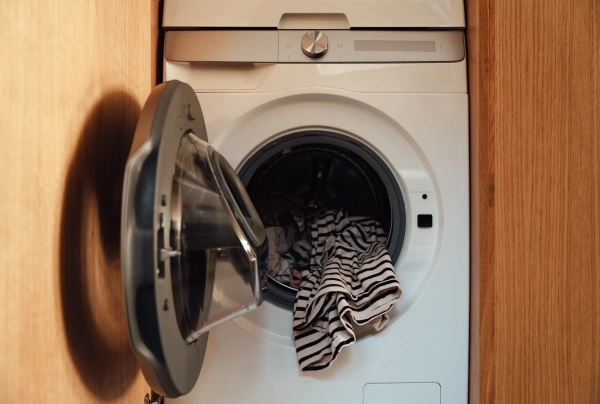“`html 
If there were a guiding figure for Uplifting News, it would be Hans Rosling, the Swedish professor specializing in global health issues.
Good News
A recurring compilation of narratives charting advancement globally.
Email (required)Sign UpBy submitting your email, you agree to our Terms and Privacy Notice. This site is protected by reCAPTCHA and the Google Privacy Policy and Terms of Service apply.
Rosling, who passed away in 2017, possessed an exceptional talent for utilizing data and storytelling to dispute widespread fallacies about worldwide development and headway. With statistical evidence at his fingertips, Rosling could persuade even the most resolute skeptic that the world was, on the whole, advancing. A prime illustration of Rosling’s skill is evident in his 2010 TED presentation titled “The Magic Washing Machine.”
“Laundry day” once entailed a full day dedicated to soaking garments, warming water, carrying, scrubbing, rinsing, squeezing, and suspending. However, while standing on stage alongside the most rudimentary washing machine imaginable, Rosling recounted the initial experience his family had with such a device. His fascinated grandmother observed the spinning drum as if it were a cinematic presentation, while his mother sat down and engaged in an unprecedented activity on laundry day: She immersed herself in reading a book.
That’s the crux of the matter. For individuals of Rosling’s mother’s era, a washing machine transcended its function as a mere appliance; it symbolized a conduit to time itself. It generated time — time for education, income generation, relaxation, and parental duties. And the progression witnessed over the last century in what could be termed domestic technology has afforded people — particularly women — the autonomy to allocate their time as they desire.
In the United States, the revolution in household appliances, featuring washing machines, dishwashers, and microwave ovens — coupled with the electrification necessary for their operation — diminished the burden of housework from approximately 60 hours per week at the commencement of the 20th century to around 28 hours by 1970, and subsequently below 20 by 2005. The time spent specifically on food preparation decreased from roughly 65 minutes daily in 1965 to approximately 37 minutes daily in 2014.
Related
- The current administration contends that inexpensive merchandise is not part of the American ideal. They are mistaken.
Given that women predominantly undertook — and continue to undertake — those extensive hours of domestic labor, the appliance transformation signifies a substantial, yet insufficiently recognized, enhancement in women’s lives particularly. It may prove challenging for us to fully acknowledge this reality now, having become accustomed to these miraculous machines over several decades; however, individuals at the time comprehended the correlation. The proposition was unambiguous: Kitchens underwent redesign to emulate the efficiency of a manufacturing facility, and advertisers promoted these appliances as instruments of liberation. Certain scholars posit that labor-saving devices, alongside the widespread adoption of universal plumbing and electrification, served as a foundational requirement for a landscape in which women now constitute nearly half of the American workforce.
Although such appliances initially catered to affluent individuals, their prices gradually declined over time, and presently, approximately 85 percent of American households possess a washing machine. (As Vox contributing editor Kelsey Piper noted earlier this year while contemplating the ongoing trade conflict, we should not disregard the worth of affordable goods.) It is currently trendy to denounce America’s culture of convenience, and indeed, it entails tangible environmental and societal repercussions. Nonetheless, presented with the option, few among us, I surmise, would opt to revert to an era when manual laundry consumed an entire day.
The Global Laundry Divide
To gain insight into such an existence, one need only observe the realities of the approximately four billion individuals who persist in laundering clothes by hand. These individuals are disproportionately located in low-income nations, where access to electricity, running water, and reasonably priced appliances remains limited. A compelling recent report by the Washing Machine Project (TWMP), a non-governmental organization established by engineer Navjot Sawhney, reveals that in affluent nations, only about 0.4 percent of individuals engage in manual laundry; conversely, in low-income nations, the figure approximates 98 percent.
Manual laundry is not merely a quaint anachronism; it constitutes a significant expenditure of time and a threat to well-being, disproportionately impacting women and girls. Data pertaining to time allocation, gathered by TWMP across various countries, paints a harsh picture. In Kampala, Uganda, respondents indicated expending an average of 147 minutes per load — nearly 13 hours per week. Within refugee communities in the Republic of the Congo, the figure stood at 149 minutes per load, with certain women dedicating 20 to 24 hours weekly solely to laundry. Such extensive time commitments displace opportunities for education, income generation, caregiving, and even simple rest.
Individuals performing manual laundry in these countries frequently bear the additional burden of procuring water themselves. Within the Ugandan capital of Kampala, manual laundry consumed approximately 14 gallons per load. In Mexico, measured usage extended to 16 to 53 gallons — substantially exceeding the water volume potentially utilized for drinking purposes alone. Acquiring this water can pose dangers. Surveys conducted within refugee camps in Greece indicated that 35 percent of respondents harbored apprehensions regarding harassment or theft during collection, while those in the Congo cited perils encompassing robbery and gender-based violence.
Additionally, the sheer physical strain of the labor itself is notable. Within a refugee camp situated on the Greek island of Lesvos, 87 percent of individuals reported experiencing physical discomfort as a result of laundering garments — affecting hands and backs universally, legs in most instances — in addition to skin damage and injuries stemming from rudimentary tools.
“The soap was abrasive to the skin and nails,” one refugee conveyed. Beyond time, physical well-being is compromised.
Bridging the divide
The enchantment of the contemporary washing machine emanates not solely from the appliance itself, but also from the availability of potable water, plumbing infrastructure, and electrification prevalent in affluent nations. Nonetheless, strides can be made even within regions characterized by extreme poverty.
Sawhney’s manually operated Divya washer, powered by a hand crank, alleviates both the time and exertion required for laundry in resource-constrained environments. Field data collected in Uganda demonstrates an average reduction in wash time from approximately 2.5 hours to approximately 29 minutes — a decline of roughly 80 percent. Over the course of a month, laundry-related time shrank from approximately 13 hours to marginally exceeding one hour.
The cascading effects of this time savings are palpable. At Kenya’s Shangilia School, curtailing wash time by half liberated students to engage in reading, soccer, chess, and academic pursuits. Staff members reported diminished aches and reduced anxiety regarding water access. Across Uganda and Congo, families indicated utilizing the time dividend for caregiving, and within select households, men initiated participation in laundry duties — a subtle yet meaningful transition in gender dynamics. Economic benefits also accrue. In Kampala, detergent expenses decreased from approximately $63 to $20 weekly following the adoption of the machine — savings that accumulate within households characterized by annual incomes approximating $840.
It is facile to dismiss washing machines and dishwashers as mere conveniences, perhaps even prompting feelings of mild culpability. However, “convenience” is an inadequate descriptor for machines that have bestowed upon us the gift of time. The utilization of that time remains at our discretion, but I posit that 4 billion individuals would aspire to possess that same prerogative.
An iteration of this article initially featured in the Good News newsletter. Subscribe here!
“`
Source: vox.com






